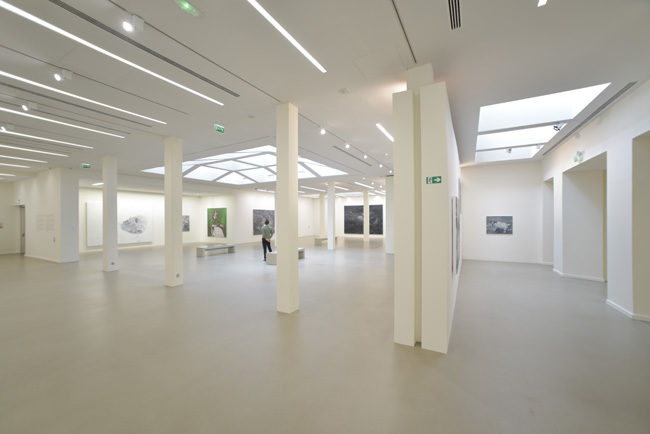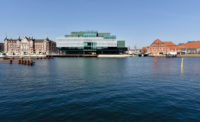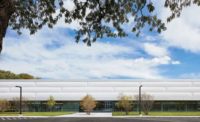Arles, France
Arles has been an important commercial and cultural center for centuries, and it has several impressive ancient and Romanesque monuments to prove it. But the small city in southern France's idyllic Provence region is known to most of the world for an out-of-towner who briefly called the sunny port on the banks of the Rhône home more than 125 years ago.
Though Vincent van Gogh made Arles famous for the hundreds of unforgettable images of cafés, gardens, vineyards, and starry nights he created there at the zenith of his artistic production, until now the city had no venue to properly showcase those masterpieces. The new museum for the local Fondation Vincent van Gogh, with the support of the Van Gogh Museum in Amsterdam, enthusiastically embraces art—van Gogh's and more recent works—and the amazing light that drew the Dutch painter to Arles. And it does so with an innovative renovation of a historic four-story stone manor house in the center of the city that includes a two-story steel, wood, and glass addition within its courtyard.
“Van Gogh came to Arles because the light here is very special, so we had to do something very special with the light,” says Guillaume Avenard, the Avignon-based co-principal of Fluor Architecture, the 10-year-old firm he founded with Hervé Schneider. The young designers—who met while working at the studio of Fran'ois Seigneur, Jean Nouvel's first partner—were prepared to take on the challenge of revamping the 15th-century Hôtel Léautaud de Donines into a state-of-the-art gallery space; they had previously transformed Arles's 2,000-year-old Roman amphitheater into a temporary stage for summer festivals, complete with the necessary modern amenities.
At the museum, visitors encounter a dazzling light show immediately upon entering. Just past the 39-foot-long entrance gate, onto which French artist Bertrand Lavier painted the name “Vincent,” based on the artist's signature, there is an elaborate glass sculptural project by Swiss artist Raphael Hefti. Installed atop the glass roof of the elevated museum store (made of solar-control glazing), this intricate construction dances with color, creating jewel-like reflections around the courtyard and, most dramatically, within the shop itself.
At the request of Bice Curiger, the artistic director of the Fondation, whose vision it was to incorporate the work of contemporary artists into the new building—a third piece comprises a musical installation by Swiss composer Fritz Hauser within a stairwell—Fluor worked closely with Hefti in developing the technical details of the kaleidoscopic installation. The final composition features 78 uniquely colored glass panels in 52 sizes, the largest of which is just over 9 feet long. The laminated sheets of glass have a dichroic coating—multiple fine layers of metal oxides that selectively pass light through narrow bands of color while reflecting other hues. The glass sheets are braced by a steel frame and mounted to the steel roof beams at different angles. By absorbing ultraviolet rays, they also help maintain a temperate climate and protect the shop's merchandise from sun damage.
“The position of the panels was determined by physical mock-ups, not computer simulations,” explains Avenard. “The problem was how to transmit the colors without allowing too much sunlight and heat inside. The mock-up didn't work when we tried it in Paris. There really is an exceptional light in Arles.” (Arles's yearly average of sunny days is 80 percent, and they are notable for high color contrast and shadows, quite different from the diffuse light common in northern Europe.)
The architects faced an even greater challenge designing skylights for the grand gallery that would take advantage of that exceptional light while maintaining conservation standards. “Daylight is the best way to show the spectrum of colors,” says Laurent Escaffre of Ingélux Consultants, who helped modulate the natural light and devise an ancillary electric lighting scheme. “We want the benefit of daylight without the risks to the artwork.”
The unique solution they came up with is a series of what the architects call “sheds,” which produce a mountain-like topography on the roof over the gallery, just out of reach of a public deck where museum visitors can stroll. There are a total of 27 of the wood-clad forms, 21 of which feature north-facing glass panels tilted at varying degrees. (Six unglazed sheds are used for storage and housing technical equipment.)
The glazing comprises two layers. Between them is a .05-inch-thick screen of tiny metal louvers that blocks all of the direct sunlight and almost 90 percent of the sun's heat. “We needed that shield,” explains Escaffre. “It cuts out sunbeams but is hardly visible.” Daylight is blocked entirely by a blackout shade when particularly sensitive or valuable paintings are being displayed.
Smaller galleries on the south side of the building feature motorized shades over windows whose opening and closing is calculated in advance by a predetermined algorithm based on geographic and seasonal considerations, rather than as a reaction to specific conditions via sensors.
LED track lighting, with angles and power intensities precisely calculated for temporary exhibits, which are expected to change three times a year, supplements natural light. According to Escaffre, “LED lighting has become more pervasive in museums. It can render blues better than halogens, and is better for dimming.”
“There were so many surprises in this project,” recalls Avenard. “The final result is not what we had in our heads at the beginning, but being inside the spaces is magical, and it was an especially nice moment when the first van Gogh arrived.”
People
Formal name of building:
Location:
Completion Date:
Gross square footage:
Total project cost:
Total construction cost:
Client:
Architect:
Personnel in architect's firm who should receive special credit:
Fany Guiol, Chief of Staff/Registered Architect
Marianne Ravisat
Associate artists:
Interior designer:
Engineers:
Consultant(s): Acoustical: R2M
Other:
Contractors:
Photographer(s):
© FLUOR architecture |
Products
Structural system
Manufacturer of any structural components unique to this project:
Roofing
Windows
Glazing
Doors
Hardware
Interior finishes
Furnishings
Lighting
Conveyance Plumbing DURAVITE
Energy |






















